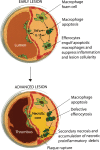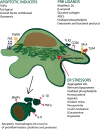Mechanisms and consequences of macrophage apoptosis in atherosclerosis
- PMID: 18953058
- PMCID: PMC2674693
- DOI: 10.1194/jlr.R800032-JLR200
Mechanisms and consequences of macrophage apoptosis in atherosclerosis
Abstract
Macrophage apoptosis is an important feature of atherosclerotic plaque development. Research directed at understanding the functional consequences of macrophage death in atherosclerosis has revealed opposing roles for apoptosis in atherosclerotic plaque progression. In early lesions, macrophage apoptosis limits lesion cellularity and suppresses plaque progression. In advanced lesions, macrophages apoptosis promotes the development of the necrotic core, a key factor in rendering plaques vulnerable to disruption and in acute lumenal thrombosis. The first section of this review will examine the role of phagocytic clearance of apoptotic macrophages, a process known as efferocytosis, in the dichotomous roles of macrophage apoptosis in early vs. advanced lesions. The second section will focus on the molecular and cellular mechanisms that are thought to govern macrophage death during atherosclerosis. Of particular interest is the complex and coordinated role that the endoplasmic reticulum (ER) stress pathway and pattern recognition receptors (PRRs) may play in triggering macrophage apoptosis.
Figures


References
-
- Mantovani A., P. Allavena, A. Sica, and F. Balkwill. 2008. Cancer-related inflammation. Nature. 454 436–444. - PubMed
-
- Tabas I., K. J. Williams, and J. Boren. 2007. Subendothelial lipoprotein retention as the initiating process in atherosclerosis: update and therapeutic implications. Circulation. 116 1832–1844. - PubMed
-
- Yan Z-Q., and G. K. Hansson. 2008. Innate immunity, macrophage activation, and atherosclersis. Immunol. Rev. 219 187–203. - PubMed
-
- Libby P., and S. K. Clinton. 1993. The role of macrophages in atherogenesis. Curr. Opin. Lipidol. 4 355–363.
Publication types
MeSH terms
Substances
Grants and funding
LinkOut - more resources
Full Text Sources
Medical

